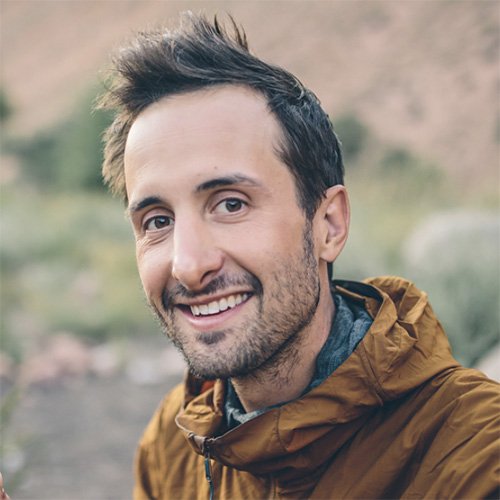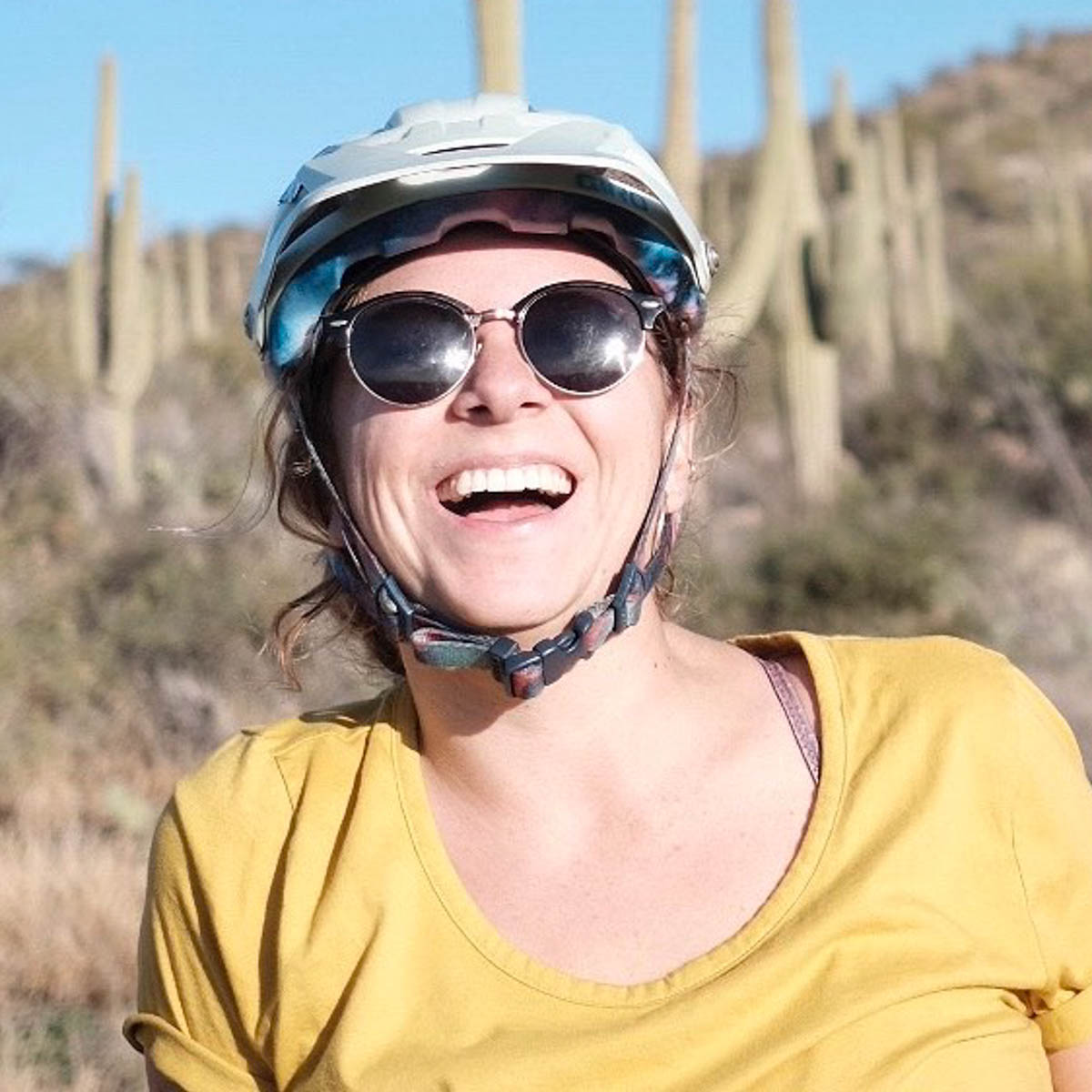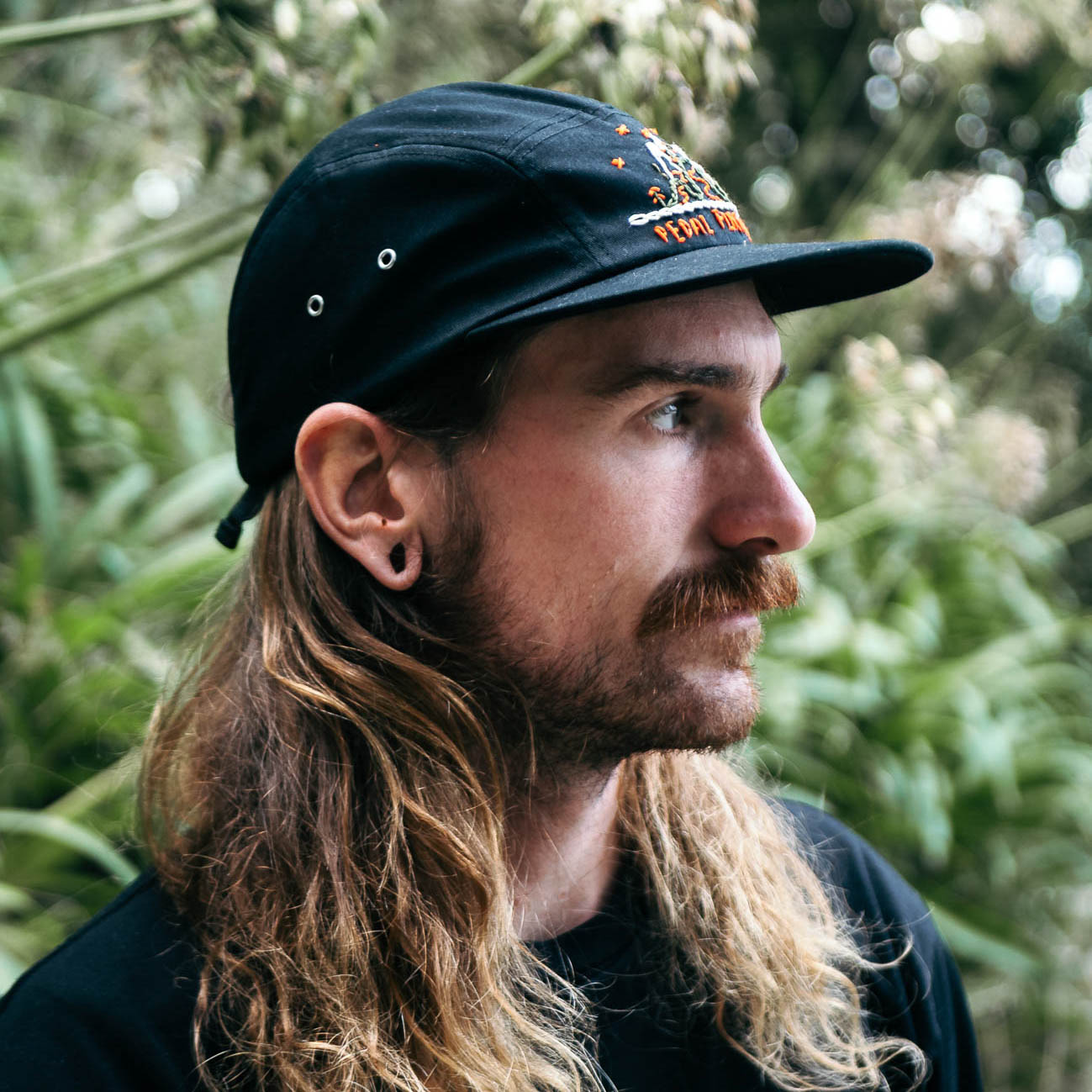One Question, Five Voices: What’s in Your Cooking Kit?
Share This
In this edition of One Question, Five Voices, we ask five bikepackers to give us a detailed look at the cooking kits they trust to prepare tasty meals while on the go. Find five unique takes on a lightweight camp kitchen here, plus a handful of tips and tricks…
In an earlier installment of One Question, Five Voices, we had five riders share the tool kits they haul into the backcountry for those inevitable moments when mechanical issues arise. Just as important as having the right tools to make repairs in the field is having a foolproof system for cooking before and after a long day’s ride. Food is fuel, and your ability to prepare it dependably can make or break a trip. This time around, five bikepackers walk us through the tried and true cooking kits they use to whip up a variety of meals at camp.
What’s in your camp cooking kit?
My current cooking setup is largely driven by the fact that I wanted hot coffee in the mornings while on the Baja Divide. Though I tried to pack light for the 1,700+ mile ride, bringing a pot, cup, and a way to heat it all up was essential. Our go-to for cooking on this route has been the good old fashion campfire. We have found Baja to be dry, with small sticks abundant! As a backup, and to be used in places where open fire is inappropriate, I carry a pop can stove I made just for this occasion. Though denatured alcohol can be hard to track down at times, I’ve always found it when needed. I have been carrying eight ounces, which is enough for me to cook four to six meals. Instead of carrying a pot stand, I rely on balancing rocks to elevate my pot (also abundant in Baja).
One thing that’s been a major improvement to my kit is a pot insulator. Made from Reflectix material, it helps my food continue cooking when it’s off the fire, conserving alcohol when I might be running low and keeping my food warm on chilly nights.
I always carry a spoon, knife, and lighter in my fanny pack as these items are useful throughout the day. This makes my cooking setup a breeze to pack, with the pots fitting into each other, the stove rolling into my handkerchief (used during cooking, both for messes and hot pot handling) and nestling nicely with my pot insulator inside.
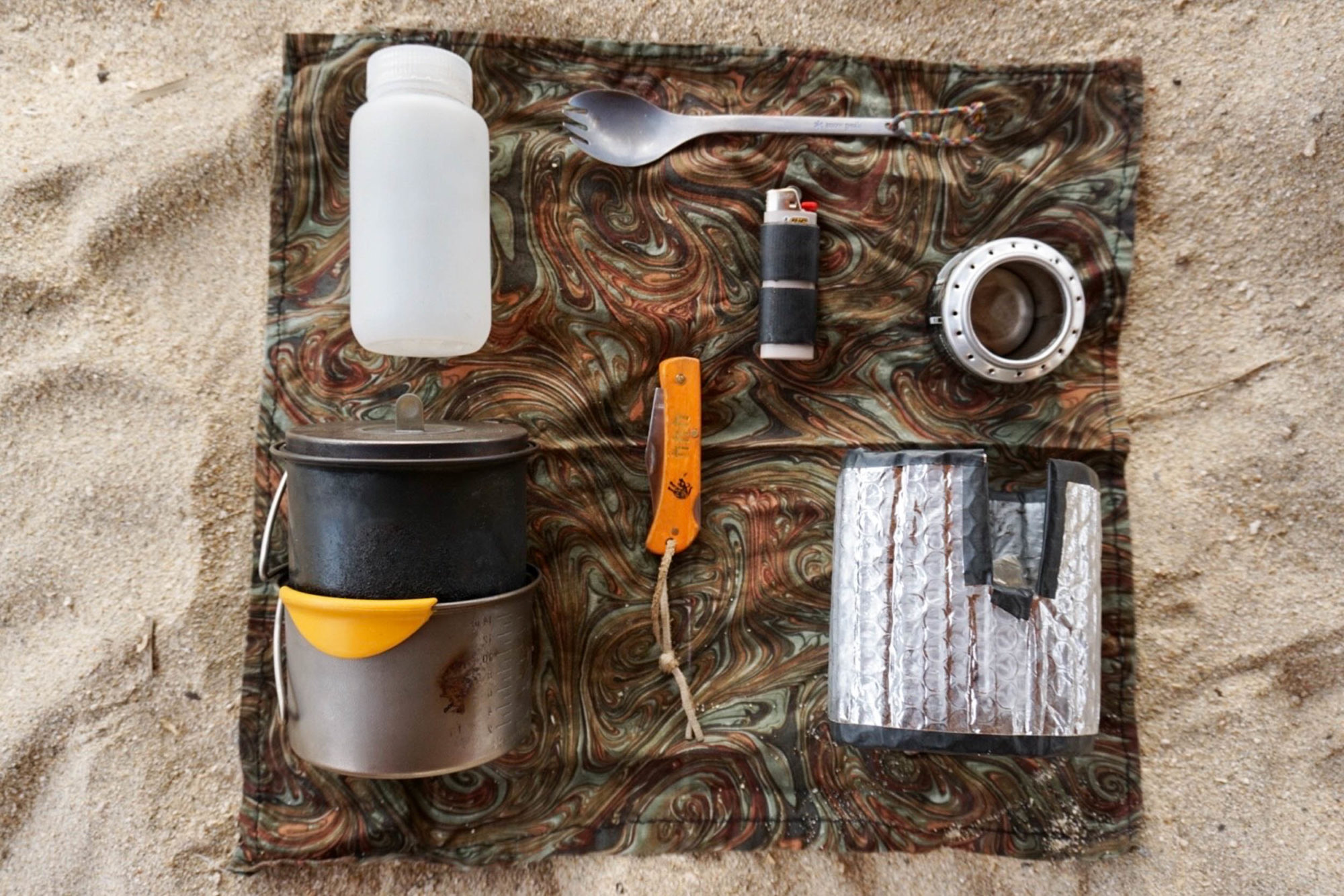
Sophie’s Cooking Kit:
-Pot insulator
-8 oz. denatured alcohol
-Pop can stove
-Snow Peak Hot Lips
-Snow Peak Ti Spork
-Pocket knife
-Lighter wrapped in gorilla tape
-Handkerchief
My core cooking gear has remained largely unchanged for ten years! Simple, quiet, and reliable, it centres around my faithful Trangia stove and a Clikstand support, though I have been dabbling with the twig-powered Solo Stove recently. I use bioethanol when I can, carried in a 250ml Nalgene flask (note Riv/Enve sticker), or recycled 500ml Coke bottle, which typically sees me through several days on the road depending on altitude, weather, and use. I team my Trangia with a 1.2L Evernew Ti pot, which is wide-bottomed enough to actually fry vegetables and actually cook properly. Bought at the same time as the support, it now sports the most wonderful patina and is held shut with an old piece of inner tube. Recently on the Baja Divide, I also carried a titanium grill (not pictured) welded by my friend Dave Salinas, perfect for toasting tortillas over the fire! If you don’t have a Dave in your life, Ruta Locura makes them too.
The rest of my cooking gear includes a sealable bowl; I love Sea to Summit’s flat-pack X-Seal and Go—a birthday gift from my son Sage—that I use to eat and drink from. It doubles up as a chopping board, flat packs neatly into my framebag, and it’s really handy for carrying restaurant leftovers – in addition to my Stasher silicone bag. I tend to stockpile rubber bands and pack a few reusable zip lock bags for storing pre-made dehydrated food or bulk buy trail mix, or any treats I find on the road. When riding in the US Southwest or Mexico, I also pack a small Nalgene container for sea salt, the perfect condiment to a ripe avocado. If I’m expecting a dry camp site, I carry a few litres of extra water in a lightweight Hydrapak Seeker; I’ve repaired a couple of holes successfully with Seamgrip.
I have a Sea to Summit coffee strainer that I’m currently borrowing; it balances over my bowl with two tent stakes or twigs. Otherwise, I’m a fan of the GSI Outdoor Ultralight Java Drip. Failing that, cowboy style! Because I love the print so much, I’ve taken to indulging myself with a Monumental Loop ‘Food Chain’s a Bitch’ bandana for picnic spreads. In addition to my Opinel knife, I should also give a shout out to my wooden spoon, which I proudly carved myself. It’s even usurped my favourite old titanium Snowpeak spork!

Cass’ Cooking Kit:
-Clikstand S-2 support
-Evernew 1.2L ti pot
-250ml fuel bottle
-Nalgene Straight Side Jar (2fl oz)
-Sea to Summit X-Seal and Go Collapsible Container
-Stasher silicone bag (sandwich size)
-A few zip locks bags and rubber bands
-Hydrapak Seeker 3L
-Monumental Loop ‘Food Chain’s a Bitch’ bandana
-Sea to Summit X-Brew coffee dripper or GSI Outdoor Ultralight Java Drip
-Opinel Knife no. 10
-Homemade wooden spoon
-Dave’s Ti Grill when tortillas are on the menu
This is my overnighter cooking kit. It’s nothing fancy since all I need is the ability to boil water for coffee and porridge in the morning. Before riding out, I’ll stash a dinner in the reusable container, often something like falafel and roasted veggies. Then the container is reused to soak my pre-prepared porridge mix overnight. In the morning, I finish cooking it by adding boiling water and top with granola, seasonal fruit and maple syrup. For coffee, the GSI Ultralight dripper has mostly superseded my Aeropress as my bikepacking coffee-making implement. It basically folds up into nothing and weighs all of 14 grams. It’s designed to be used without a paper filter, but I find the extraction is too unpredictable this way, so I bring a V60 filter and a ziplock bag to pack out the used filter and coffee grinds.
The BRS-3000 stove is tiny, flimsy, and cheap. Mine has been perfectly reliable, but I wouldn’t trust it for any extended trip except as a backup. Your mileage may vary depending on the copy. The kit is rounded out with a normal spoon (backpacking spoons often seem designed for form over function), a mini Bic lighter, and a folding knife. I don’t have a dedicated bag for all these bits, it just all gets thrown in my basket or frame bag.
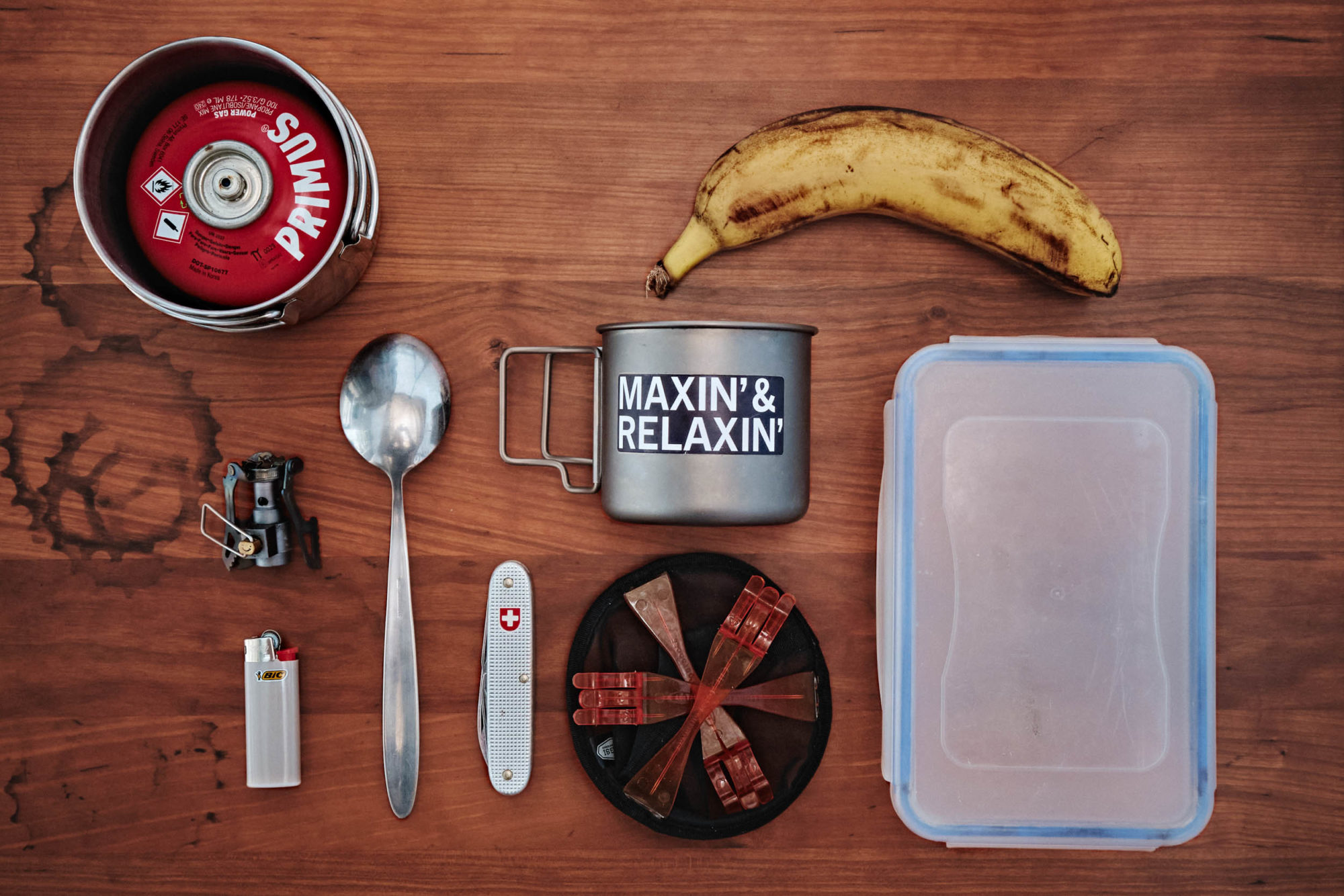
Josh’s Cooking Kit:
-100g gas cartridge
-Mini Bic lighter
-550ml steel mug for boiling water
-250ml titanium mug for coffee
-GSI Ultralight dripper
-Reusable container (lid functions as cutting board)
-Ziplock bag for carrying the small bits
-Spoon from cutlery drawer
-Backup banana
During the first three months of our trip down the Andes, my partner Andy and I lost nearly 20 kilograms between the two of us. It’s laughably obvious in hindsight, but we simply weren’t eating enough food. That, and the inevitable vomiting and diarrhoea. We set off with the trusty 1.3L pot that had cooked hundreds of meals for us for over a decade whilst hiking and travelling. Our lack of understanding about the preposterous enormousness of the cyclist’s appetite was cute.
Part way through our multi-year trip we changed from the small pot, pan, Trangia alcohol burner, and Caldera Cone setup to a multi-fuel stove with a larger pot and pan. The move to cooking with petrol was a reluctant one, but our hand was mostly forced by difficult access to alcohol in Central Asia. We made peace with it when we discovered we could make a mighty fine cheese toastie with the new non-stick pan (pro tip: put cheese on the inside and the outside).
There are no mugs dangled in the making of this cooking setup. It’s almost as if someone obsessed for ages about how to nest everything neatly into one tidy package (that someone was Andy, not me). The 2L titanium pot nestles into the frying pan. Tucked neatly into the pot is everything else, bar the fuel bottle and burner: a small circular cutting board, stackable cups, folding coffee filter, utensils, odds and ends. Despite efforts to keep the weight of this all down, we have been known to carry vast quantities of spices, herbs, and seasonings, including whatever local goods we find. Favorites included Aji Merken (a local smoked chili) in Chile, Chimmichuri in Argentina, and mystery masala mixes in India. Bland camp food is an unnecessary tragedy at the end of a day’s riding. Even in lean times, a pot of instant mashed potato flakes can still be acceptably tasty once suitably spiced and seasoned!

Eileen’s Cooking Kit:
-Montbell Alpine 16 non-stick frypan
-Small wooden spatula
-Small chopping board
-2 plastic cups
-2 sporks
-GSI javadrip coffee filter
-Tiny tube of dishwashing liquid
-Lighter
-Small rag for handling hot things
-MSR Whisperlite with 591ml fuel bottle
-Modified MSR windshield (trimmed, clips added)
-Whisperlite service kit
-Leatherman Skeletool (also part of the bike repair kit)
-Mesh bag and velcro strap
My personal cook set is pretty basic. This is due to a number of factors, the biggest one being that I’m pretty forgetful! I have to be pretty mindful about making sure I’ve repacked everything. Over the last few years I’ve slimmed my kit down to try to save weight here and there and to make it simpler. I’ve moved from a multi-fuel stove (that I just couldn’t get along with), to a gas canister stove, to a beer-can stove, and have now finally settled on a Speedster alcohol stove. It’s great! Super easy to use, packs down small, and is super safe. The custom windshield goes perfectly with my titanium Alpkit mug and provides just enough heat for everything I want to eat. The mug is not the biggest but if I need any extra room for hot water I just ferry it into the Klean Kanteen. I’m not one for cooking up a gourmet meal and tend to be pretty happy with some form of random hot pot/curry/pasta/veggie/peanut butter concoction. This leaves more time for taking photos in the evening, so the simpler the meal the better in my books.
Other items in my cooking kit include a platypus gravity filter that I love as I can just fill it up, dangle it off my tent, and prepare my meal while the water is working its way through the system. I’ll normally leave it behind if going on a shorter trip where water availability isn’t a problem. A Leatherman with a sharp knife is used for chopping duties, (I had a beautiful wooden Swiss army knife that my girlfriend Clare bought me, but it went walkies in New Zealand somewhere). To round the kit out, I’ve got a solitary fork and a 500ml nalgene to hold the fuel for the stove.

Matty’s Cooking Kit:
-Speedster alcohol 30ml burner
-Speedster combined windshield/pot rest
-Tin foil for floor shield
-Lighter
-Leatherman
-Alpkit Myti mug 650ml
-Klean Kanteen Wide 40oz
-Platypus Gravity filter
-Alpkit fork
-Nalgene 500ml bottle for fuel
What’s the centerpiece of your camp kitchen? Let us know in the comments below!
Please keep the conversation civil, constructive, and inclusive, or your comment will be removed.












